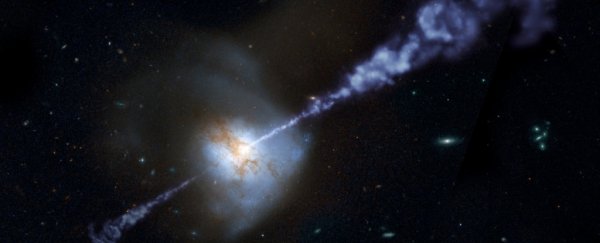In November 2014, an intense signal was picked up by telescopes all around the world - a black hole 300 million light-years away captured a passing star and tore it apart, devouring its matter.
An analysis of radio signals following the event has revealed a close relationship between the rate at which the black hole feeds, and the jet of electromagnetic energy it erupts.
Black holes are the most powerful forces in the Universe, but we know comparatively little about them - in large part because they absorb all visible light, we just can't look at them like we can almost everything else.
What some black holes do emit is electromagnetic energy in the form of relativistic jets - powerful streams of radiation and particles erupting at near light-speed from the poles of active, or feeding, black holes.
We don't know what powers these jets - but now a radio echo, detected 13 days after that 2014 feeding event, might contain the answer.
At an over 90 percent match with the feeding event X-ray emissions, researchers from MIT and Johns Hopkins believe they've captured evidence of a jet of material streaming out of the black hole while the star's matter falls in.
They believe the similar patterns between the jet and the feeding event suggest that the power of the jet is controlled by the rate at which the black hole devours the star, also known as a tidal disruption event.
"This is telling us the black hole feeding rate is controlling the strength of the jet it produces," MIT postdoc and lead author Dheeraj Pasham said.
"A well-fed black hole produces a strong jet, while a malnourished black hole produces a weak jet or no jet at all. This is the first time we've seen a jet that's controlled by a feeding supermassive black hole."
A tidal disruption event occurs when a star gets too close to the event horizon, or point of no return, of a black hole. The tidal force of the black hole will pull on the star; however, because the black hole's gravitational field is so strong, the star gets pulled apart, forming an accretion disc around the black hole spiralling in towards the centre.
These are intense, violent and energetic events, and they emit bursts of energy across the entire electromagnetic spectrum. The X-ray emissions are thought to emanate from the extremely hot inner part of the accretion disc, and optical and ultraviolet from the outer part. The radio emissions are a little more mysterious, the researchers said.
"We know that the radio waves are coming from really energetic electrons that are moving in a magnetic field - that is a well-established process," Pasham said. "The debate has been, where are these really energetic electrons coming from?"
One hypothesis is a shockwave that energises the surrounding plasma. But if that were the case, the pattern of resulting radio waves would look very different from the X-ray pattern from the matter falling into the black hole from the accretion disc.
Pasham and his co-author, Sjoert van Velzen of Johns Hopkins, found that just wasn't the case with this data. In this case, the radio data looked very similar to the X-ray data they had already examined.
The fluctuations that occurred in the X-ray data showed up again in the radio data 13 days later - although at 400,000 times the size of the Sun, the radio-emitting region was much bigger than the X-ray emitting region, at only 25 times the size of the Sun.
"The only way that coupling can happen is if there is a physical process that is somehow connecting the X-ray-producing accretion flow with the radio-producing region," Pasham said.
"It's not a coincidence that this is happening. Clearly there's a causal connection between this small region producing X-rays, and this big region producing radio waves."
They believe that these results indicate a jet that started to stream from the black hole not long after it began to feed. But because the jet is so close to the black hole, the radio waves at the source were absorbed by other electrons, and only began to emit some distance away. This explains the lapse in time.
We now know that black holes drive galactic evolution. If this new research holds true and black hole jets are proportional to the material they devour, it could shed some further light on this process, and help model simulations of evolving galaxies.
The research has been published in The Astrophysical Journal.
